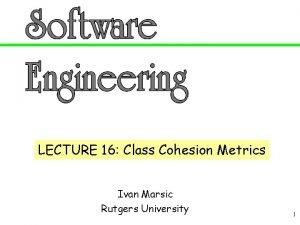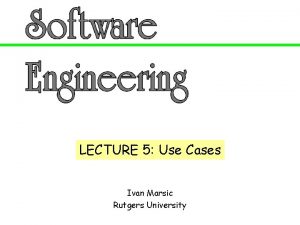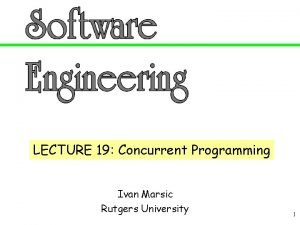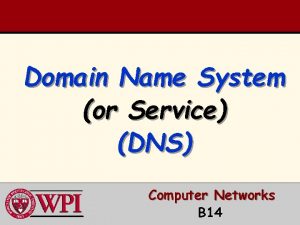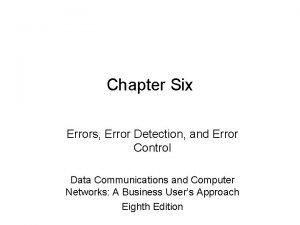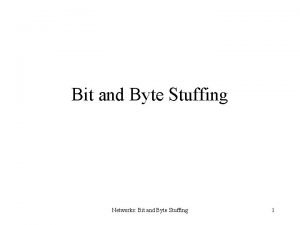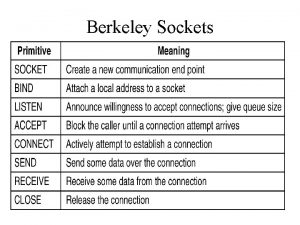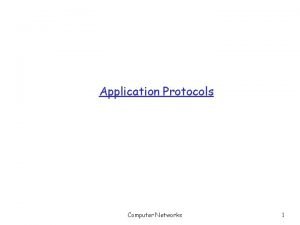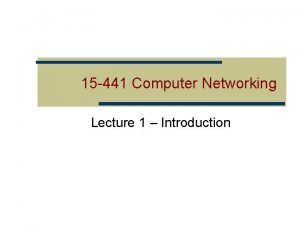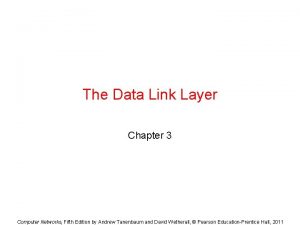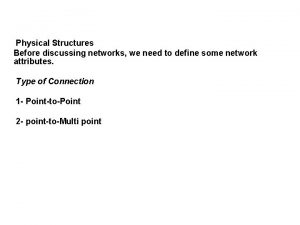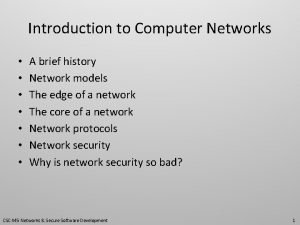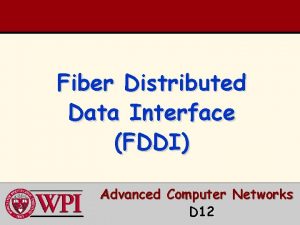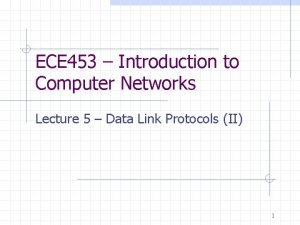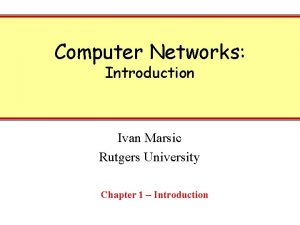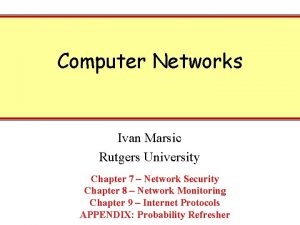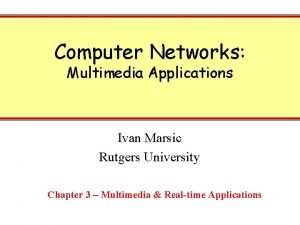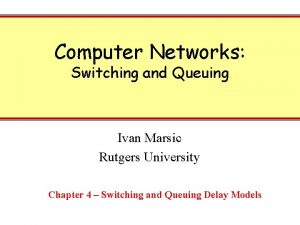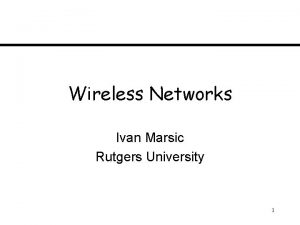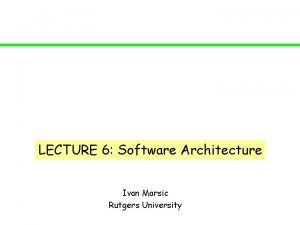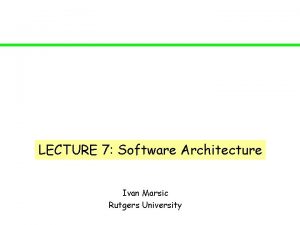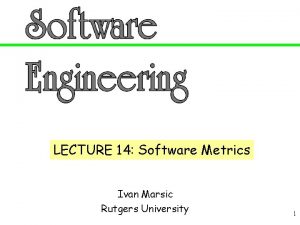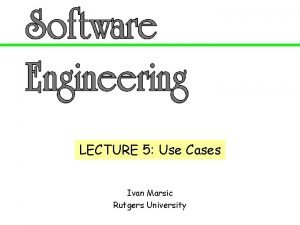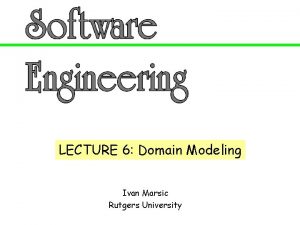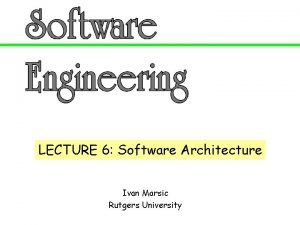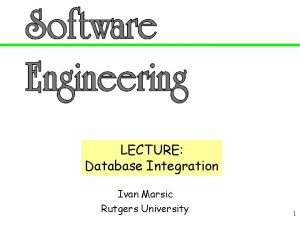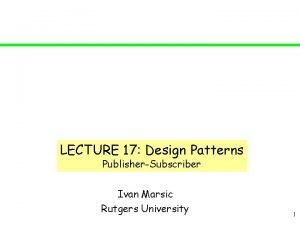Computer Networks Ivan Marsic Rutgers University Chapter 7




















































- Slides: 52

Computer Networks Ivan Marsic Rutgers University Chapter 7 – Network Security Chapter 8 – Network Monitoring Chapter 9 – Internet Protocols APPENDIX: Probability Refresher

Network Security Chapter 7

Topic: Secure Communication · Network Security Problem · Symmetric and Public-Key Cryptosystems · Cryptographic Algorithms · Authentication

Network Security Problem Secure/Confidential Communication ? 4

Objectives of Information Security • Confidentiality: information not disclosed or revealed to unauthorized persons • Integrity: consistency of data—preventing unauthorized creation, modification, or destruction • Availability: legitimate users are not unduly denied access to resources, including information resources, computing resources, and communication resources • Authorized use: resources are not used by unauthorized persons or in unauthorized ways

Message Encoding and Decoding • Encoding takes a message M and produces a coded form f(M) • Decoding the message requires an inverse function , such that = M.

Two Basic Types of Cryptosystems • Symmetric systems: both parties use the same (secret) key in encryption and decryption transformations • Public-key systems (aka asymmetric systems): the parties use two related keys, one of which is secret and the other can be publicly disclosed

Public-Key Cryptosystem 8

Public-Key Cryptosystem - mod 9

Public-Key Cryptography In RSA, receiver does the following: • Randomly select two large prime numbers p and q, which always must be kept secret. • Select an integer number E, known as the public exponent, such that (p 1) and E have no common divisors, and (q 1) and E have no common divisors. • Determine the product n = p q, known as public modulus. • Determine the private exponent, D, such that (E D 1) is exactly divisible by both (p 1) and (q 1). In other words, given E, we choose D such that the integer remainder when E D is divided by (p 1) (q 1) is 1. • Release publicly the public key, which is the pair of numbers n and E, K = (n, E). Keep secret the private key, K = (n, D).

Example: send the plaintext “hello world” • receiver chooses p = 5 and q = 7 • receiver chooses E = 5, because 5 and (5 1) (7 1) have no common factors. Also, n = p q = 35 • receiver chooses D = 29, because i. e. , they are exactly divisible. • receiver’s public key is K = (n, E) = (35, 5), which is made public. The private key K = (n, D) = (35, 29) is kept secret.

Example, cont’d Encryption Plaintext letter Plaintext numeric representation BE Ciphertext BE % n h 8 85 = 32768 85 % 35 = 8 e 5 55 = 3125 55 % 35 = 10 l 12 125 = 248832 125 % 35 = 17 l 12 248832 17 o 15 155 = 759375 155 % 35 = 15 Decryption Ciphertext CD B = CD % n Plaintext letter 8 829 = 154742504910672534362390528 829 % 35 = 8 h 10 1000000000000000 5 e 17 481968572106750915091411825223071697 12 l 15 12783403948858939111232757568359375 15 o

Example, cont’d • While the adversary knows n and E, he or she does not know p and q, so they cannot work out (p 1) (q 1) and thereby find D.

Topic: Authentication · Network Security Problem · Symmetric and Public-Key Cryptosystems · Cryptographic Algorithms · Authentication

Authentication Protocol (1) Assumption: Only Sender needs to be authenticated to Receiver, not mutually. Secure communication is not enough … playback attack:

Authentication Protocol (2) Solution to playback attack:

Impersonation Attack PROBLEM: Public key distribution … Adversary impersonates Bank PROBLEM: Customer unaware that Adversary obtained his account info!

Network Monitoring Chapter 8

Packet-pair Dispersion


Internet Protocols Chapter 9

The Internet Reference Model Visit http: //en. wikipedia. org/wiki/Internet_reference_model for more details on the Internet reference model http: //en. wikipedia. org/wiki/OSI_model

IPv 6 Header

IPv 6 Address Prefix Assignments

IPv 6 Global Unicast Address

Example IPv 6 Extension Headers

Format of IPv 6 Extension Headers

RIP Header (for IPv 4)

OSPF Directed Graph of an AS (a) (b)

OSPF Header (for IPv 4)

OSPF - LSA Header

e. BGP and i. BGP Sessions

BGP Finite State Machine

Detail from Figure 1 -49:

BGP Header & Message Formats

BGP UPDATE Message

Example BGP UPDATE Message

BGP MULTI_EXIT_DISC (MED) Attribute

Address Resolution Protocol (ARP) Need for multiple addresses, hierarchical vs. non-hierarchical

Address Resolution Protocol (ARP)

ARP Packet Format (for IPv 4)

Mobile IP

SNMP

Probability Refresher Appendix

Jar with Black & White Balls

Random Events Possible outcomes of two coin tosses: “Tree diagram” of possible outcomes of two coin tosses:

Drawing from Jar/Urn Decided by Rolling a Die

Probability Matrix for Ball Drawing

Illustration for Bayes Theorem

Poisson Process average arrival rate = 5

Partitioning of Areas Under Normal Curve

How to Read Table A-1
 Lcom tcc
Lcom tcc Ivan marsic
Ivan marsic Ivan milat deus ex machina
Ivan milat deus ex machina Ivan marsic
Ivan marsic Martina maršić
Martina maršić Difference between datagram and virtual circuit switching
Difference between datagram and virtual circuit switching Basestore iptv
Basestore iptv Computer science department rutgers
Computer science department rutgers Crc in computer networks
Crc in computer networks Crc in computer networks
Crc in computer networks Traffic management in computer networks
Traffic management in computer networks Tanenbaum
Tanenbaum What is optimality principle in computer networks
What is optimality principle in computer networks In band management definition
In band management definition What is optimality principle in computer networks
What is optimality principle in computer networks Uses of computer in business
Uses of computer in business Classify computer networks based on transmission technology
Classify computer networks based on transmission technology Intro dns
Intro dns Integrated and differentiated services in computer networks
Integrated and differentiated services in computer networks Icmp in computer networks
Icmp in computer networks Http computer networks
Http computer networks Framing in computer network
Framing in computer network Dns in computer networks
Dns in computer networks Computer networks assignment
Computer networks assignment Computer networks vs distributed systems
Computer networks vs distributed systems Badrinath
Badrinath Error detection computer networks
Error detection computer networks Error detection and correction in computer networks
Error detection and correction in computer networks Internet transport protocol in computer networks
Internet transport protocol in computer networks Error control in computer networks
Error control in computer networks Subnet
Subnet Data link layer switching in computer networks
Data link layer switching in computer networks Apdatal
Apdatal Bit stuffing in hdlc
Bit stuffing in hdlc Bit and byte stuffing
Bit and byte stuffing Bit stuffing vs byte stuffing
Bit stuffing vs byte stuffing Socket primitives in computer networks
Socket primitives in computer networks Arp vs rarp
Arp vs rarp In ftp protocol client contacts server using
In ftp protocol client contacts server using Principles of network applications
Principles of network applications Switching techniques in computer networks
Switching techniques in computer networks Cmu computer networks
Cmu computer networks Utopian simplex protocol
Utopian simplex protocol Sonet network
Sonet network Cell switching in computer networks
Cell switching in computer networks Physical structures in computer networks
Physical structures in computer networks Explain osi reference model
Explain osi reference model Network layer is concerned with
Network layer is concerned with History of computer network
History of computer network What is fddi in computer network
What is fddi in computer network Fast ethernet network
Fast ethernet network Exponential backoff in computer networks
Exponential backoff in computer networks Unrestricted simplex protocol
Unrestricted simplex protocol
